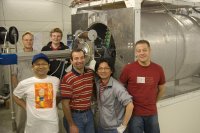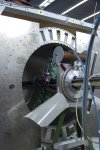 |
 |
|||||||||||||
|
|||||||||||||
|
|||||||||||||
|
Three pairs of eyes cast one last look around the room. Have all scissors, ladders, metallic tables been removed? No pins or pens lying around anymore? Once the team is sure that nothing is left in the area, they close the security doors and give the go-ahead – the magnet that has been to space can be charged for the first time since its arrival at its new home in the DESY test beam. Before its field of 1 Tesla can bend the tracks of particles in a EUDET detector prototype, however, the scientists have to map the field very precisely. And they don't want steel-capped boots flying into the coil.
On-site preparations for this modern kind of map-making started last week. The team from CERN brought their mapping machine - a complicated device with a long arm, two side arms with Hall probes and a big disc with regular holes that looks a bit like something from a gym. The team from KEK cooled it down over the weekend. Now, after last tests on the mapping machine and the positions it is supposed to measure the field, everything was ready to go. The whole operation is part of the Europe-funded EUDET testbeam infrastructure, in which the space magnet will play a major role. On top of the mapping, they magnet team has developed a new monitoring system and devices that make the magnet efficient, stable and safe for other test beam users in the area. The teams from the three different labs - KEK, DESY and CERN - have been working on installing the magnet and designing and building machines, sensors and software for several months. “I worked on the design at home because I had so many other things to do at CERN,” says Pierre-Ange Giudici, who also mapped the fields of ALICE, LHCb and ATLAS. He is responsible for the mechanical structure that holds the Hall probes, drives them into the magnet along the z-axis, stopping every 14 millimetres for a measurement, and rotates them around 360 degrees, stopping at every five degrees. His colleague Felix Bergsma is the designer of the Hall probes. There are 24 of them - six on each side of each side arm. A bit like navigation satellites, they give 3-D information on the field inside the magnet. When their sensors are perpendicular to the magnetic field lines, the scientists record the voltage in the probe. “Every probe has 30 parameters - temperature, for example,” explains Bergsma. “When we collect the voltage data from three probes and compare the results, we can reconstruct which field must have existed to create those voltages.” With every position within the coil measured like this and read out with a custom-made software, the team can make a complete 3-D map of the field. This map will be essential for collaborations who want to use the magnet to test their detector prototypes later. They compare their data with the field map, which will help explain why certain particles dashed off in the direction and with the energy they did. The mapping process will take about three days, and the complete map will be available shortly after. It will be published on the EUDET website. -- Barbara Warmbein |
|||||||||||||
| © International Linear Collider |

